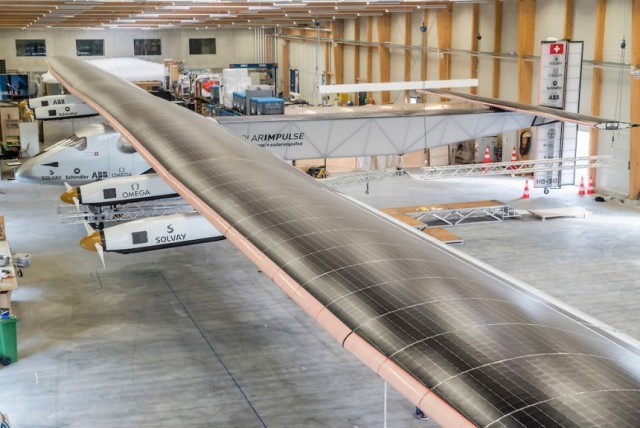Taking to the skies usually requires a lot of fossil fuels, but a team from Switzerland intends to fly around the globe using only the free energy raining down from the sun. The aircraft is called Solar Impulse 2, and it’s scheduled to take flight in 2015, powered by a massive array of 17,248 solar panels. Even with all those panels to drink up the sun, it will take Solar Impulse 2 about twenty days of flying time to make the trip.

The engineers behind this contraption have done everything possible to wring every drop of power out of the sun’s rays. Researchers have been working feverishly to improve solar power tech over the years, but it’s not nearly enough to keep anything like a regular plane in the air for long. The Solar Impulse 2 has a wingspan of 72 meters, which is larger than a standard Boeing 747. Despite the vast dimensions, Solar Impulse 2 weighs in at only 2,300 kg (5,070 lbs) — about the same as a Ford Fiesta sedan — with a small single-person cockpit.
In order to get the craft’s weight down to these impressive levels and also keep it from shaking itself apart in the air, the team opted to use carbon fiber composites. Even then it was a challenge to fabricate wing sections that could provide lift for days at a time without failing. Yes, days at a time — Solar Impulse 2 is designed to take a slow and steady approach to circumnavigating the globe. Its top speed is just 140 kph (88 mph), so it will fly for as long as a week before landing for crew swaps and possible maintenance.

What about all those long, dark nights with no sunlight? The Solar Impulse 2 is actually designed to charge its custom-designed lithium-ion batteries during the day rather than divert all that power to the four spinning turbines directly. This is one of the reasons for the lower top speed — the plane needs to save a lot of juice for nighttime flying. The batteries weigh 366 kg (809 lbs), or about a quarter of the plane’s total mass.
The other power conservation strategy at work has to do with altitude. Solar Impulse 2 will climb to 8,500 meters (5.28 miles) during the day, where it can reach its maximum speed and store more solar energy for the night. As dusk arrives, the plane will descend to an altitude of 1,500 meters (0.9 miles) where its speed slows and it’s easier to remain aloft.

The expected 20 days of flight time will take place over a few months as the team keeps close watch over the state of the plane. This will be the longest trip for a solar-powered plane by far, and there’s no telling what unexpected situations could arise. A little time to stretch one’s legs is important too — the lone pilot for each leg of the journey (there will be two who switch off after each section) is confined to a 3.8x3m unpressurized cockpit the entire time.

Solar Impulse 2 cockpit diagram
This endeavor simultaneously shows us how far solar technology has come, and how much farther it still has to go. You’re probably not going to be hopping on a solar plane any time soon, but we’re closer now than ever before.
via http://www.extremetech.com/



